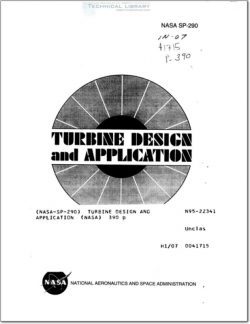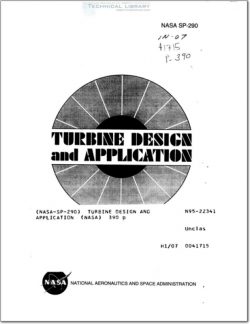NASA-SP-290

- Version
- 223 Downloads
- 15.83 MB File Size
- 1 File Count
- August 18, 2016 Create Date
- August 18, 2016 Last Updated
Turbine Design and Application

NASA has an interest in turbines related primarily to aeronautics
and space applications. Airbreathing turbine engines provide jet and
turboshaft propulsion, as well as auxiliary power for aircraft. Pro-
pellant-driven turbines provide rocket propulsion and auxiliary
power for spacecraft. Closed-cycle turbine engines using inert gases,
organic fluids, and metal fluids have been studied for providing
long—duration electric power for spacecraft. Other applications of
interest for turbine engines include land-vehicle (cars, trucks, buses,
trains, etc.) propulsion power and ground-based electrical power.
In view of the turbine-system interest and efforts at Lewis Research
Center, a course entitled “Turbine Design and Application” was
presented during 1968—69 as part of the In-House Graduate Study
Program. The course was somewhat revised and again presented in
1972—73. Various aspects of turbine technology were covered including
thermodynamic and fluid-dynamic concepts, fundamental turbine
concepts, velocity diagrams, losses, blade aerodynamic design, blade
cooling, mechanical design, operation, and performance.
The notes written and used for the course have been revised and
edited for publication. Such a publication can serve as a foundation
for an introductory turbine course, a means for self-study, or a
reference for selected topics.
Any consistent set of units will satisfy the equations presented.
Two commonly used consistent sets of units and constant values
are given after the symbol definitions. These are the SI units and
the US. customary units. A single set of equations covers both
sets of units by including all constants required for the US. customary
units and defining as unity those not required for the SI units.
| File | Action |
|---|---|
| NASA-SP-290 Turbine Design and Application.pdf | Download |

Comment On This Post